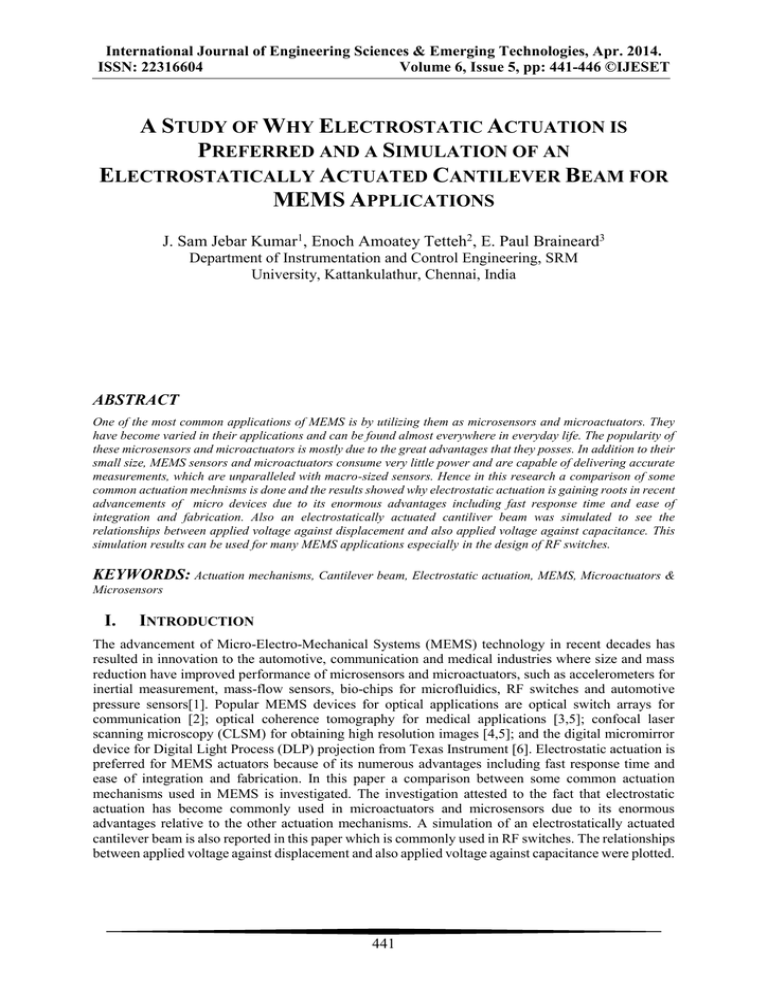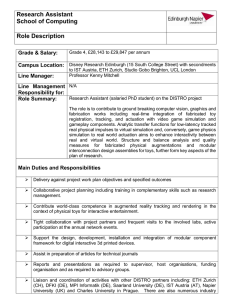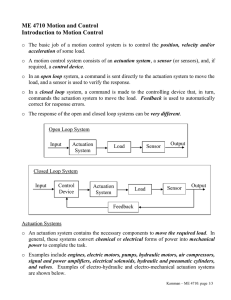a study of why electrostatic actuation is preferred and a
advertisement

International Journal of Engineering Sciences & Emerging Technologies, Apr. 2014. ISSN: 22316604 Volume 6, Issue 5, pp: 441-446 ©IJESET A STUDY OF WHY ELECTROSTATIC ACTUATION IS PREFERRED AND A SIMULATION OF AN ELECTROSTATICALLY ACTUATED CANTILEVER BEAM FOR MEMS APPLICATIONS J. Sam Jebar Kumar1, Enoch Amoatey Tetteh2, E. Paul Braineard3 Department of Instrumentation and Control Engineering, SRM University, Kattankulathur, Chennai, India ABSTRACT One of the most common applications of MEMS is by utilizing them as microsensors and microactuators. They have become varied in their applications and can be found almost everywhere in everyday life. The popularity of these microsensors and microactuators is mostly due to the great advantages that they posses. In addition to their small size, MEMS sensors and microactuators consume very little power and are capable of delivering accurate measurements, which are unparalleled with macro-sized sensors. Hence in this research a comparison of some common actuation mechnisms is done and the results showed why electrostatic actuation is gaining roots in recent advancements of micro devices due to its enormous advantages including fast response time and ease of integration and fabrication. Also an electrostatically actuated cantiliver beam was simulated to see the relationships between applied voltage against displacement and also applied voltage against capacitance. This simulation results can be used for many MEMS applications especially in the design of RF switches. KEYWORDS: Actuation mechanisms, Cantilever beam, Electrostatic actuation, MEMS, Microactuators & Microsensors I. INTRODUCTION The advancement of Micro-Electro-Mechanical Systems (MEMS) technology in recent decades has resulted in innovation to the automotive, communication and medical industries where size and mass reduction have improved performance of microsensors and microactuators, such as accelerometers for inertial measurement, mass-flow sensors, bio-chips for microfluidics, RF switches and automotive pressure sensors[1]. Popular MEMS devices for optical applications are optical switch arrays for communication [2]; optical coherence tomography for medical applications [3,5]; confocal laser scanning microscopy (CLSM) for obtaining high resolution images [4,5]; and the digital micromirror device for Digital Light Process (DLP) projection from Texas Instrument [6]. Electrostatic actuation is preferred for MEMS actuators because of its numerous advantages including fast response time and ease of integration and fabrication. In this paper a comparison between some common actuation mechanisms used in MEMS is investigated. The investigation attested to the fact that electrostatic actuation has become commonly used in microactuators and microsensors due to its enormous advantages relative to the other actuation mechanisms. A simulation of an electrostatically actuated cantilever beam is also reported in this paper which is commonly used in RF switches. The relationships between applied voltage against displacement and also applied voltage against capacitance were plotted. 441 International Journal of Engineering Sciences & Emerging Technologies, Apr. 2014. ISSN: 22316604 Volume 6, Issue 5, pp: 441-446 ©IJESET II. ACTUATION MECHANISMS There are several actuation mechanisms present today which can be classified as direct and indirect actuation methods. Indirect methods may include using acoustic vibration to shake a microsensor much like a piece of paper in front of a speaker vibrates from the compression waves in the air. Another indirect method has a magnetic coat deposited on a microsensor such as a cantilever and an inductance coil underneath it to generate magnetic fields that attract and repel the cantilever into vibration. For direct methods, the most common is by the use of a PZT (Pb-Zr-Ti transducer or, as it is sometimes called, piezoelectric z-axis actuating transducer), which is capable of vibrating at different frequencies very accurately depending on the driving voltage [7-9]. Microactuators have been fabricated by various fabrication processes, such as Poly Multi-User MEMS Processes (PolyMUMPs), Silicon-On-Insulator MUMPs (SOIMUMPs), Metal MUMPs, and custom processes. Different fabrication processes allow us to build microactuators that can be actuated in different manners. For example, electromagnetic actuation requires ferromagnetic materials, usually Ni, to be deposited on microactuators, and this process is not compatible with standard CMOS processes. Hence, a custom process is usually employed to build electromagnetic actuators. Even though many unique actuation methods are developed, the conventional actuation methods are electromagnetic, piezoelectric, electrothermal and electrostatic actuation. 2.1. Electromagnetic Actuation Electromagnetic actuation usually uses magnetic coat commonly a ferromagnetic material like permalloy deposited on a microactuator and an inductance coil underneath it to generate magnetic fields that attract and repel the cantilever into vibration. At present, electromagnetic actuation provides more displacement than other actuation methods do. For instance, Takayuki Iseki et al. [10] implement electromagnetic actuation to displace a micromirror, achieving a large angular scan angle of 8° at 0.75 mA, while a micromirror shows a linear response to the applied current. However, its implementation is limited by its disadvantages, such as high power consumption, a complicated fabrication process regarding how to deposit ferromagnetic materials on a microactuator. Orphee Cugat et al. [11] present electromagnetic microactuators using permanent magnets. Advance in material fabrication to provide thick film deposition of magnetic materials on the surface of microactuators reduces voltage and current requirements. However, thermal dissipation imposed by current CMOS technology limits the fabrication of the magnetic film on the substrate from reaching the desired characteristics. Extensive research has been pursued in recent years to overcome these problems by incorporating other actuation methods. An example is the array of microshutters in James Webb Space Telescope (JWST) [12] opens by being pushed away, when an electromagnet runs across over the entire array of microshutters. Then, an individual side electrode latches each microshutter through the pull-in and keeps microshutters open. Each side electrode can be turned off individually to release a corresponding microshutter. Once a microshutter is released by its side electrode, an individual microshutter cannot be opened again without the electromagnet sweeping over the entire array. 2.2. Piezoelectric Actuation Piezoelectric actuation utilizes the piezoelectric effect in which piezoelectric material generates electric fields or potential difference across the material while it undergoes mechanical deformation; or piezoelectric material deforms in response to applied electric fields. In other words, piezoelectric actuation takes advantage of the corresponding mechanical deformation to applied electric field [13]. It has relatively lower operation voltage with low power consumption, better linearity and fast switching time 0.1 to 1.0 ms. 2.3. Electrothermal Actuation This actuation mechanism usually takes the form of a bimetallic strip where two dissimilar metals with different coefficient of thermal expansion are fabricated together. Due to this gradient in coefficient of thermal expansion, upon application of heat energy the strip will deflect. The main advantage of electrothermal actuation is the simplicity of the fabrication method. However, in general, thermal actuation tends to have higher power consumption and slow response time. Janak Singh et al. [14] demonstrate about 10° of angular displacement with approximately 10 ms thermal response time when 442 International Journal of Engineering Sciences & Emerging Technologies, Apr. 2014. ISSN: 22316604 Volume 6, Issue 5, pp: 441-446 ©IJESET their micromirror is excited at 1 V. The out-of-plane thermal microactuator [15] takes advantages of difference in the thermal expansion coefficients of Si and Au when it experiences ohmic heating. The configuration of the thin arm and wide arm, one end of which is fixed at the substrate, has nonlinear property due to temperature dependency. 2.4. Electrostatic Actuation Electrostatic actuation makes use of electrostatic force induced by the potential difference between a microactuator and its electrode. As its applied voltage increases, higher electrostatic force results in more displacement. For most cases, both DC bias and AC signal are used to displace a microactuator at the same time. Although the dynamics of a microactuator can be linearized within small displacement, an electrostatic microactuator is inherently nonlinear, making it more difficult for feedback control to be implemented while achieving a large displacement. Although electrostatic actuation requires higher actuation voltage than that of other actuation methods, electrostatic actuation does not require complicated fabrication methods, piezoelectric materials or ferromagnetic materials deposited on a microactuator. In addition, most electrostatic actuators require very small current, depending on the size and geometry of microactuators. In spite of this limited operation range due to the pull-in effect, nonlinear behavior in response to applied voltage, and high actuation voltage, electrostatic actuation is one of the most popular actuation methods because of its fast response time (less than 0.1 ms), low power consumption, and the easiness of integration and testing with electrical control circuitry. The advantages and disadvantages of each actuation method are summarized in the following table. Table 1. Summary of Actuation Mechanisms Actuation Mechanism Electromagnetic Piezoelectric Electrothermal Electrostatic III. Advantages Disadvantages • Low actuation voltage • Relativel large displacement • Higher switching speed • Low power consumption • Easy fabrication • Low actuation voltage • Low power consumption • Fast response time • Easy to integrate and implement with CMOS technology • Compatible with most fabrication methods • Difficult in fabrication of magnetic material with current CMOS technology • Challenge in minimizing a size of devices • Small displacement range • High actuation voltage • High power consumption • Slow response time • Thermal fatigue due to thermal cycle • High actuation voltage • Limited operation range due to the pull-in ELECTROSTATICALLY ACTUATED CANTILEVER BEAM Among many actuation methods presented in the previous section, electrostatic actuation is one of the most popular actuation methods for microactuators fabricated by MEMS technologies despite its high actuation voltage and limited operation range due to the pull-in phenomenon. Another advantage is that electrostatic actuators can be easily built by many fabrication methods, which are compatible with most CMOS technologies that are employed in order to manufacture modern analog and digital devices. Hence, electrostatic actuators can be packaged with control circuitry or measurement circuitry without much difficulty, allowing smaller and simpler products in various industrial applications. A simulation is of an electrostatically actuated microcantilever beam is show below using COMSOL multiphysics. Figure 1 shows profile of surface electric potential and figure 2 profile of surface total displacement. 443 International Journal of Engineering Sciences & Emerging Technologies, Apr. 2014. ISSN: 22316604 Volume 6, Issue 5, pp: 441-446 ©IJESET Figure 1. Profile Of Surface Electric Potential IV. Figure 2. Profile Of Surface Total Displacement RESULTS A plot of displacement against applied D.C. voltage is shown in figure 3 and also the displacement against change in capacitance is shown in figure 4. These plots prove that electrostatic actuation makes use of electrostatic force induced by the potential difference between a microactuator and its electrode. As its applied voltage increases, higher electrostatic force results in more displacement as shown in the equation below. εAV 2 FE = 2D2 Where, FE – Electrostatic Force ε - Permitivity of medium separating electrodes A – Area of Electrodes V – D.C. bias voltage D – Distance between Electrodes Figure 3. A Plot Of Displacement Vs Bias Voltage Figure 4. A Plot Of Capacitance Vs Bias Voltage 444 International Journal of Engineering Sciences & Emerging Technologies, Apr. 2014. ISSN: 22316604 Volume 6, Issue 5, pp: 441-446 ©IJESET V. CONCLUSION A comparison between conventional microactuation mechanisms has been presented. A summary of this comparison was tabulated and it showed that electrostatic actuation has more advantages which outweighs its disadvantages relative to the other actuation mechanisms. A simulation of an electrostatically actuated microcantilever beam is also reported which can be used for many sensor and actuation applications including RF switches. REFERENCES [1] [2] [3] [4] [5] [6] [7] [8] [9] [10] [11] [12] [13] [14] [15] Stephen D. Sentruria, “Microsystem Design”, Kluwer Academic Publishers, New York, 2001. John T.W. Yeow, K. L. Eddie Law, and Andrew A. Goldenberg. "SOI-Based 2-D MEMS L-Switching Matrix for Optical Networking", IEEE Jounal of Selected Topics in Quantum Electronics, pp. 603-613, 2003. John T.W. Yeow, V. X. D. Yang, A. Chahwan, M. L. Gordon, B. Qi, I. A. Vitkin, B. C. Wilson, A. A. Goldenberg, "Micromachined 2-D scanner for 3-D optical coherence tomography", Sensors and Actuators A:Physical, pp. 331-340, 2005. Dipika V. Patel, and Charles N.J. McGhee, "Contemporary in vivo confocal microscopy of the living human cornea using white light and laser scanning techniques: a major review", Clin. Experiment. Ophthalmol. 35 (1), pp. 71–88, 2007. Hiroshi Miyajima, Nobuyoshi Asaoka, Toshihiko Isokawa, Masanori Ogata, Yukihiro Aoki, Masaharu Imai, Osamu Fujimori, Masahiro Katashiro, and Kazuya Matsumoto, “A MEMS electromagnetic optical scanner for commercial confocal laser scanning microscope”, IEEE J. Microelectromech. Syst., vol. 12, no. 3, pp. 243-251, 2003. Peter F.V. Kessel, Larry J. Hornbeck, Robert E. Meier, and Michael R. Douglass, “A MEMS-Based Projection Display”, Proceedings of IEEE, vol. 86, no. 8, August, 1998. J. A. Harley, 2002, Advances in piezoresistive probes for atomic force microscopy, Ph.D Dissertation, Stanford University, Stanford, CA. A. Mehta, S. Cherian, D. Hedden, and T. Thundat, 2001, “Manipulation and controlled amplification of brownian motion of microcantilever sensors", Appl. Phys. Lett.,78(11):1637-1640. K. L. Turner and W. Zhang, 2001, “Design and analysis of a dynamic MEM chemical sensor”, Proc. Am. Control Conf., Arlington, VA, 2:1214-1218. Takayuki Iseki, Miki Okumura and Takashi Sugawara, "Two-Dimensionally Deflecting Mirror Using Electromagnetic Actuation", Optical Review, pp. 189-194, 2006. Orphee Cugat, Jerome Delamare, and Gilbert Reyne, "Magnetic Micro-Actuators and Systems (MAGMAS)", IEEE Transactions on Magnetics, pp. 3607-3612, 2003. Alexander S. Kutyrev, Richard Arendt, S. Harvey Moseley, Ray A. Boucarut, Theo Hadjimichael, Murzy Jhabvala,Todd King, Mary J. Li, James Loughlin, David Rapchun, David Scott Schwinger, and R. F. Silverberg, "Programmable Microshutter Arrays for the JWST NIRSpec: Optical Performance", IEEE Journal of Selected Topics in Quantum Electronics, vol. 10, no. 3, 2004. Robbins, William P. "High-Displacement Piezoelectric Actuator Utilizing a Meander-Line GeometryPart II:Therory", IEEE Transactions on Ultrasonics, Ferroelectrics, and Frequency Control, pp. 461-467, 1991. Janak Singh, Terence Gan, Ajay Agarwal, Mohanraj, and Saxon Liw, “3D free space thermally actuated micromirror device”, Sens. Actuators A, pp.468-475, 2005. Amarendra Atre, "Analysis of out-of-plane thermal microactuators", Journal of Micromechanics and Microengineering, pp. 250-213, 2006. AUTHORS J. Sam Jebar Kumar is presently an assistant professor at the SRM University, kattankulathur Chennai, India at the department of Instrumentation & control engineering. He holds a Master of Engineering (M.E) and has more than 5 years teaching experience. 445 International Journal of Engineering Sciences & Emerging Technologies, Apr. 2014. ISSN: 22316604 Volume 6, Issue 5, pp: 441-446 ©IJESET Enoch Amoatey Tetteh is a final year student M.Tech(Electronics & control engineering) at the SRM University in the Instrumentation and Control department. He completed his B.E(Electronics & Comm.) in 2009 at the All Nations University, Ghana. E. Paul Braineard received his M.Tech(Electrical Engg) from the Indian Institute Of Technology and is currently a senior lecturer at the instrumentation & Control department of the SRM University, Kattankulatur, Chennai, India. He is presently a Ph.D candidate and has about 6 years industrial experience. 446




